OCZ managed to release their flagship Vertex 4 SSD two months ahead of schedule when they released it in April. In our first review of the Vertex 4, we credited OCZ for their aggressive release schedule and bold move away from SandForce controllers, but had several reservations about performance. The Vertex 4 executed well in some areas, like random 4K speeds, but it struggled with mixed workloads and our real world benchmarks. That said, we knew at the time that OCZ would be tirelessly working to release an updated firmware stack that would address some of these problems, which highlights the obvious benefits of using a proprietary controller and firmware build. StorageReview has spent the past two weeks testing beta Vertex 4 firmwares as OCZ settled in on today’s release, firmware v1.4RC. The results are nothing short of astounding – the Vertex 4 performance didn’t just improve a little bit – the Vertex 4 is now one of the fastest consumer SSDs on the market.
The release candidate firmware release notes are highlighted by a near doubling of sequential write performance for lower capacity models, significant boosts of sequential read performance at low queue depths and improved performance with mixed read/write workloads. Each Vertex 4 capacity also gets a bump in peak read and write speeds.
- 128GB
- Original 1.3 Firmware R/W – 535MB/s, 200MB/s
- 1.4RC Firmware R/W – 550MB/s, 420MB/s
- 256GB
- 1.3 R/W – 535MB/s, 380MB/s
- 1.4RC R/W – 550MB/s, 465MB/s
- 512GB
- 1.3 R/W – 535MB/s, 475MB/s
- 1.4RC R/W – 550MB/s, 475MB/s
OCZ has made the firmware upgrade available on their support website, new Vertex 4 SSDs will ship with firmware v1.4 when the final build is completed in the next few weeks.
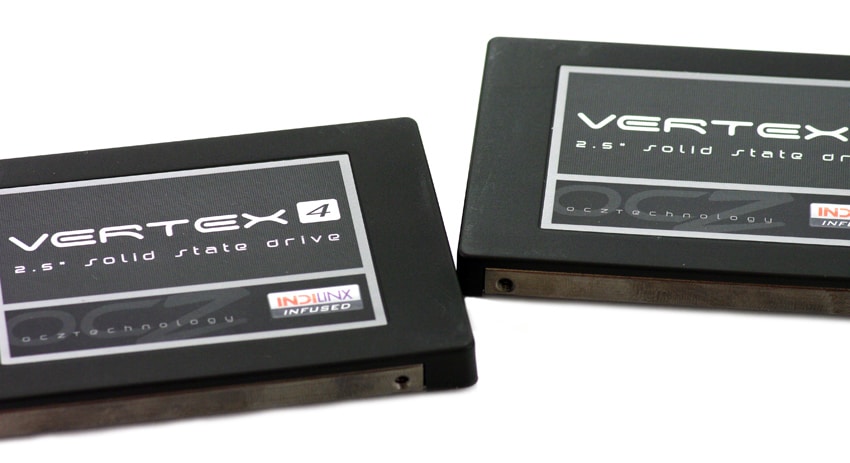
Synthetic Benchmarks
For this release candidate firmware, we take a look exclusively at the 512GB flagship Vertex 4. For the final firmware build we’ll show all the performance of all three capacities.
OCZ originally listed the Vertex 4 as having a peak sequential read speed of 535MB/s and a write speed of 475MB/s. We used IOMeter with a large-block transfer to see how the drive performed in our consumer test rig.
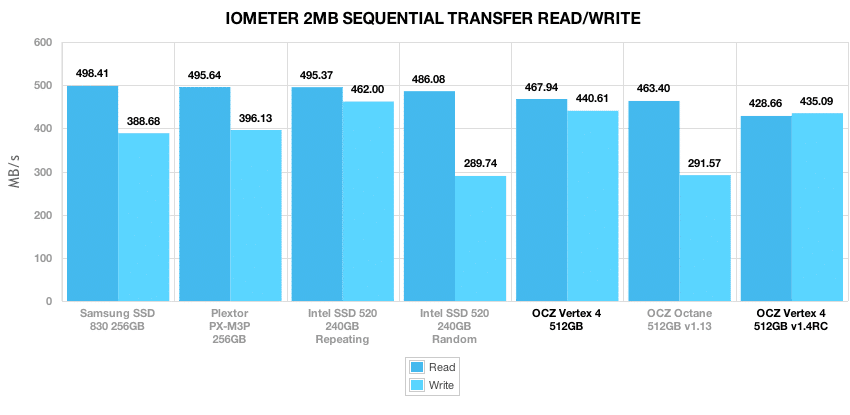
On the 512GB model, sequential 2MB transfers decreased slightly with both read and write activity.
Our next test sticks with the same large-block transfer but switches from sequential to random transactions.
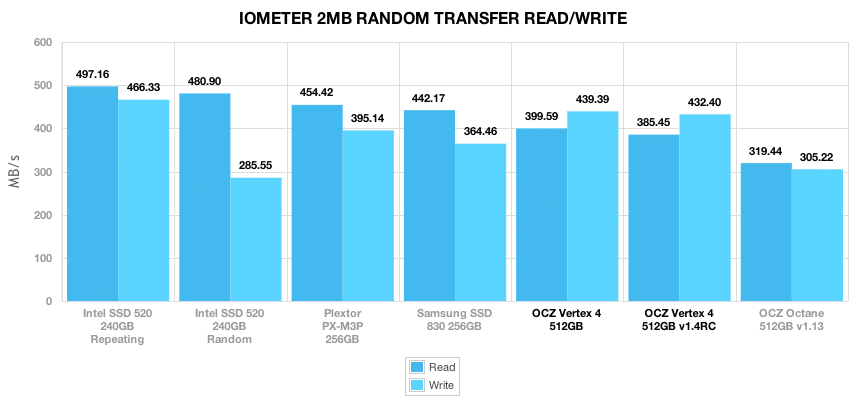
Large-block random read speeds dropped slightly, from 399 to 385MB/s, and write speeds dropped as well, from 439 to 432MB/s.
With the bread and butter of SSDs being their 4K random I/O speed, we look at low-queue depth performance, as well as expanded performance to see how well performance scales under higher queue depths.
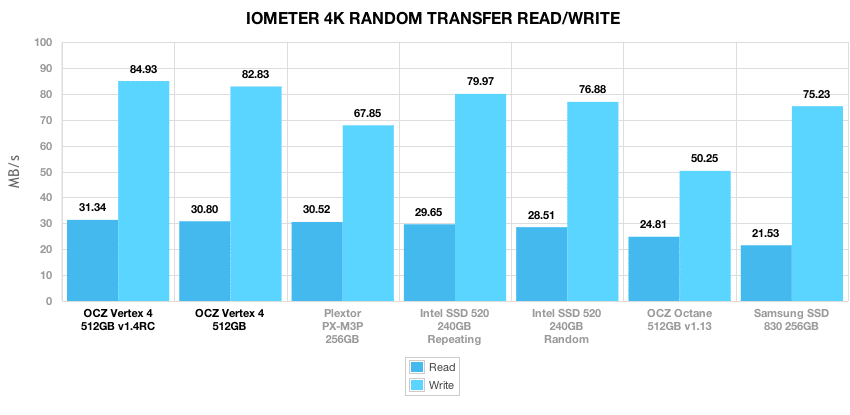
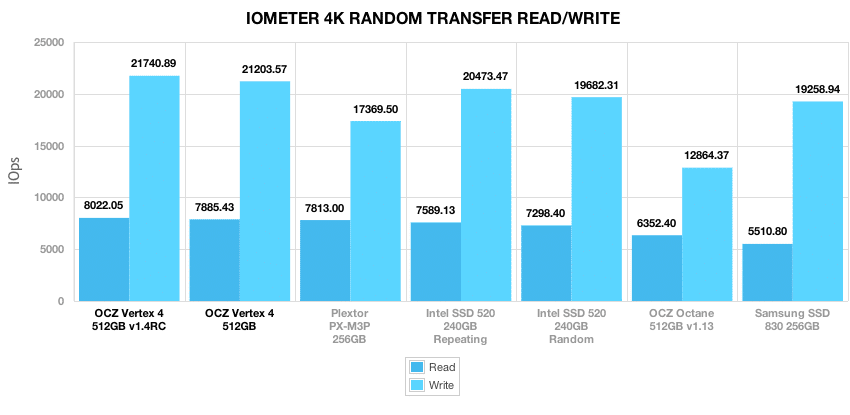
At a queue depth of 1, the OCZ Vertex 4 offered the highest 4K read and write speeds from the group. The 512GB Vertex 4 with v1.4RC measured 8,022 IOPS or 31.34MB/s 4K read and 21,740 IOPS or 84.93MB/s 4K write.
The next set of tests looks at expanded performance, to measure burst 4K read and write speed, as well as measure the peak I/O levels.
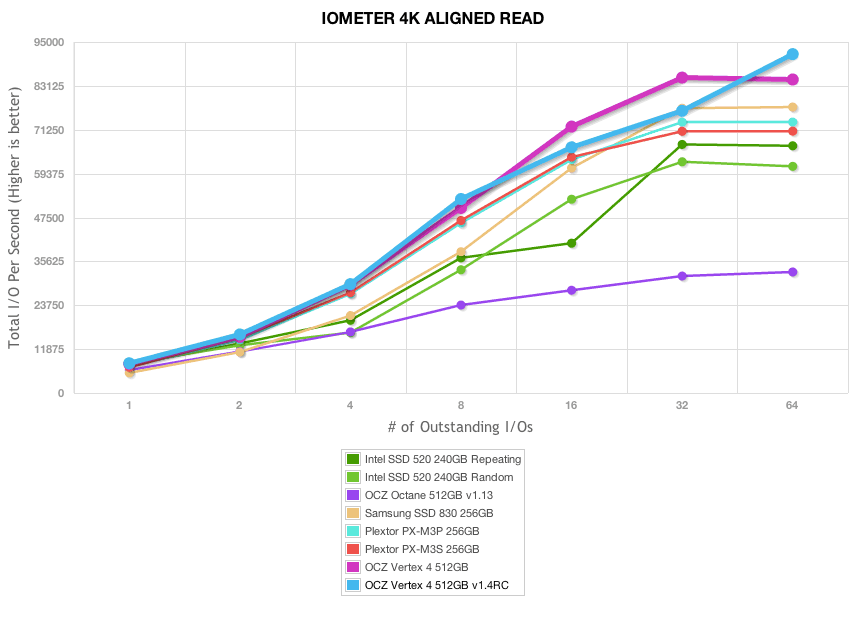
In our expanded 4K read chart the OCZ Vertex 4 with v1.4RC quickly set itself apart from the competition at the lower queue depths, reaching a peak speed of 91,708 IOPS at a queue depth of 64.
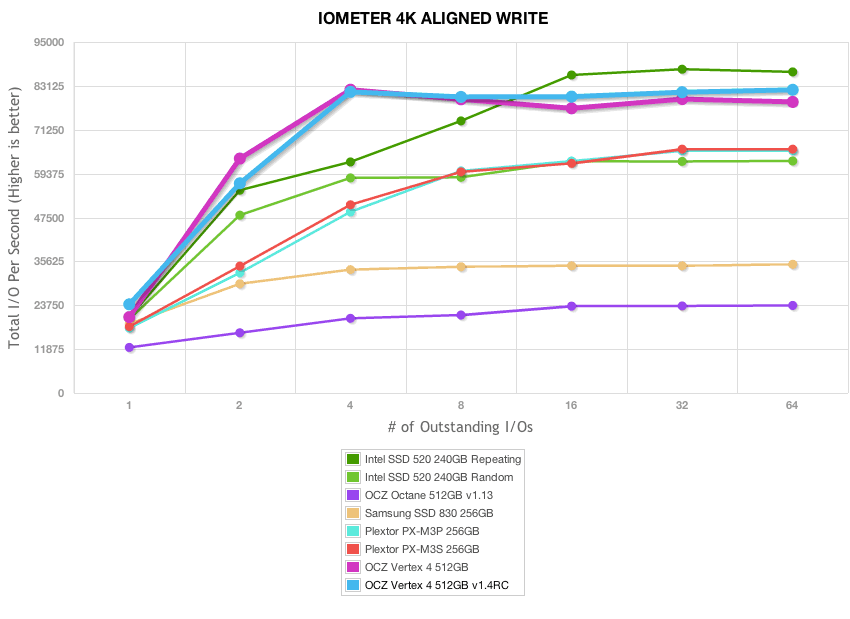
In our ramped 4K write chart, the 512GB OCZ Vertex 4 with v1.4RC flexed its muscles, peaking with speed of 82,064 IOPS at a queue depth of 64.
Expanding our QD1 4K test, we look at write latency of each SSD. Lower numbers are better, since it means less wait time for activity to process. Max latency is also important, although that number can change as the NAND wears over time. The OCZ Vertex 4 offered the lowest average and peak latency at QD1 in IOMeter. We measured an average latency of 0.0455ms from the 512GB model with 1.4RC with ultra-low peak latency of 0.99ms.
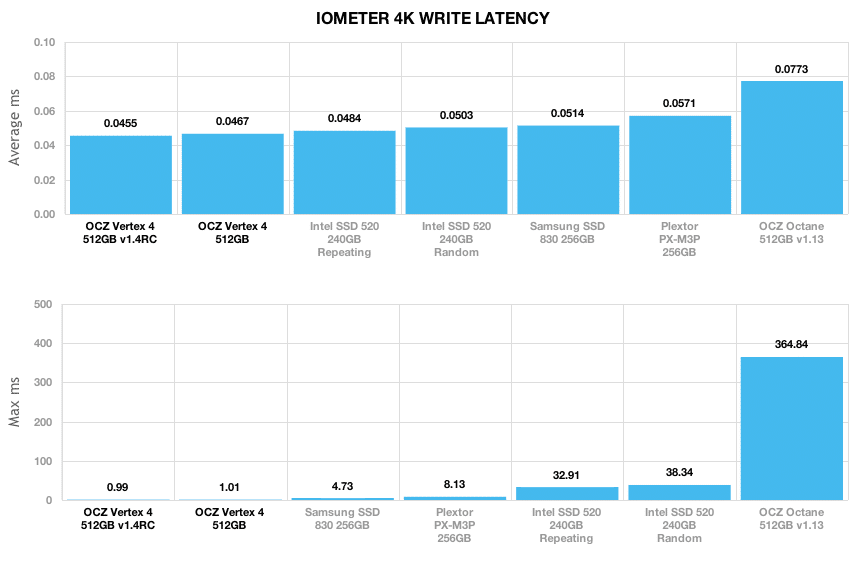
Our last group of consumer IOMeter synthetic benchmarks looks at mixed-load server profiles including Database, Workstation, File Server, and Webserver. The OCZ Vertex 4 with 1.4RC in a mixed-workload setting offered incredibly strong performance, measuring top of the pack compared to the other drives in this group, or SandForce-powered SSDs working with compressor or incompressible data.
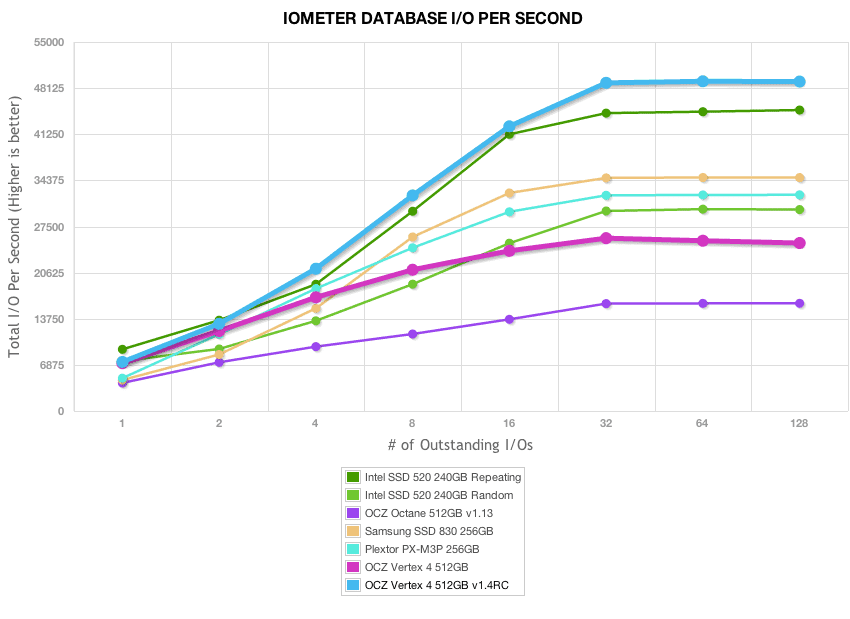
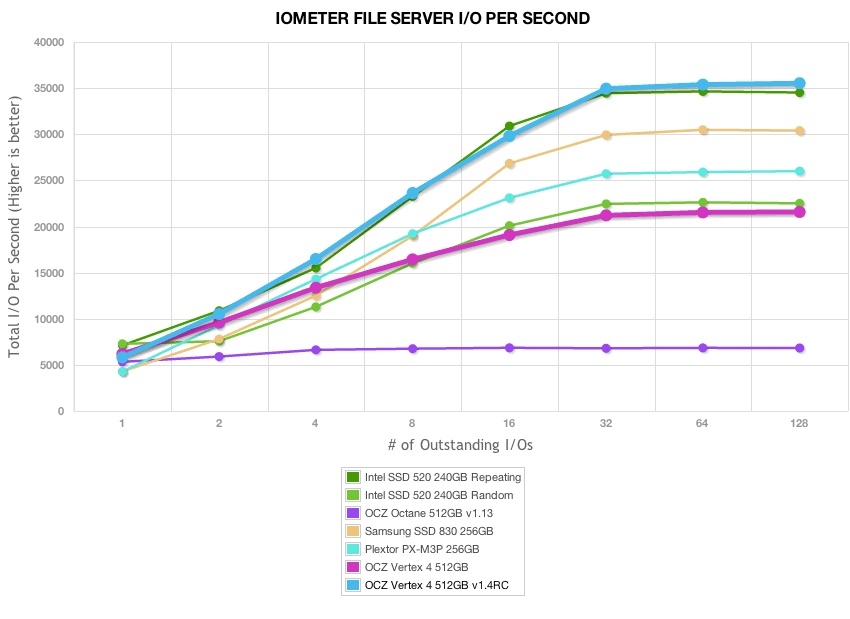
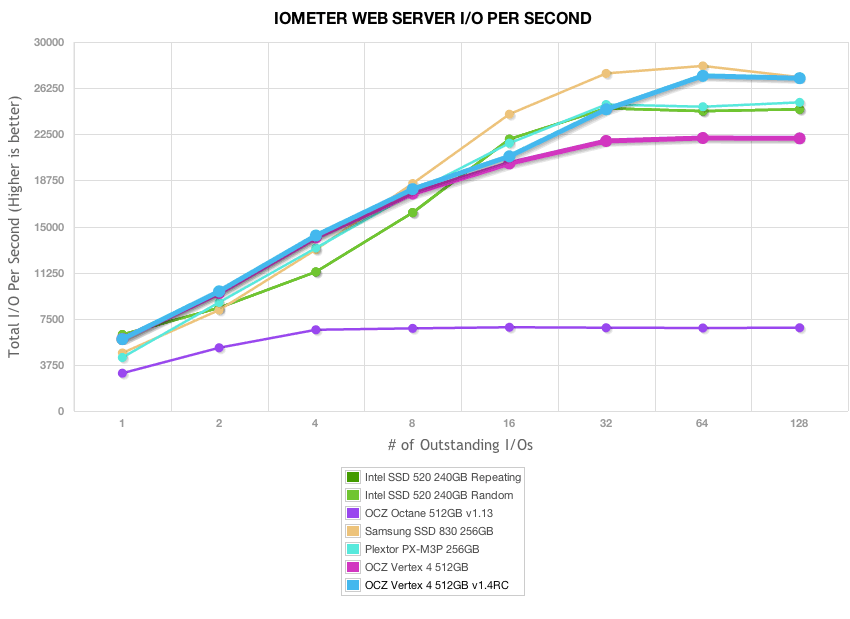
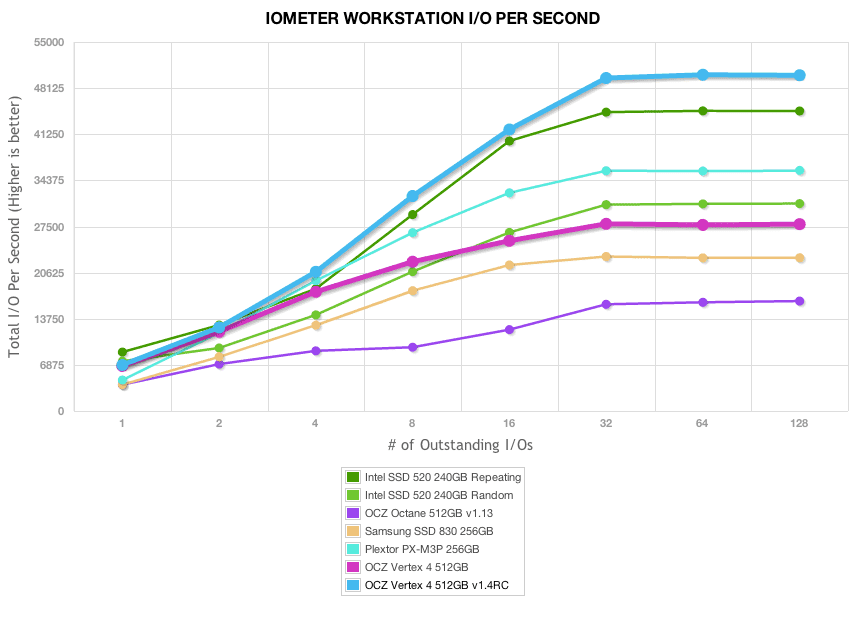
Real-World Benchmarks
For the average consumer, trying to translate random 4K write speeds into an everyday situation is pretty difficult. It helps when comparing drives in every setting possible, but it doesn’t exactly work out into faster everyday usage or better game loading times. For this reason we turned to our StorageMark 2010 traces, which include HTPC, Productivity, and Gaming traces to help readers find out how a drive might rank under their conditions.
The first real-life test is our HTPC scenario. In this test we include: playing one 720P HD movie in Media Player Classic, one 480P SD movie playing in VLC, three movies downloading simultaneously through iTunes, and one 1080i HDTV stream being recorded through Windows Media Center over a 15 minute period. Higher IOps and MB/s rates with lower latency times are preferred. In this trace we recorded 2,986MB being written to the drive and 1,924MB being read. Our second real-life test covers disk activity in a productivity scenario. For all intents and purposes this test shows drive performance under normal daily activity for most users. This test includes: a three hour period operating in an office productivity environment with 32-bit Vista running Outlook 2007 connected to an Exchange server, web browsing using Chrome and IE8, editing files within Office 2007, viewing PDFs in Adobe Reader, and an hour of local music playback with two hours of additional online music via Pandora. In this trace we recorded 4,830MB being written to the drive and 2,758MB being read.
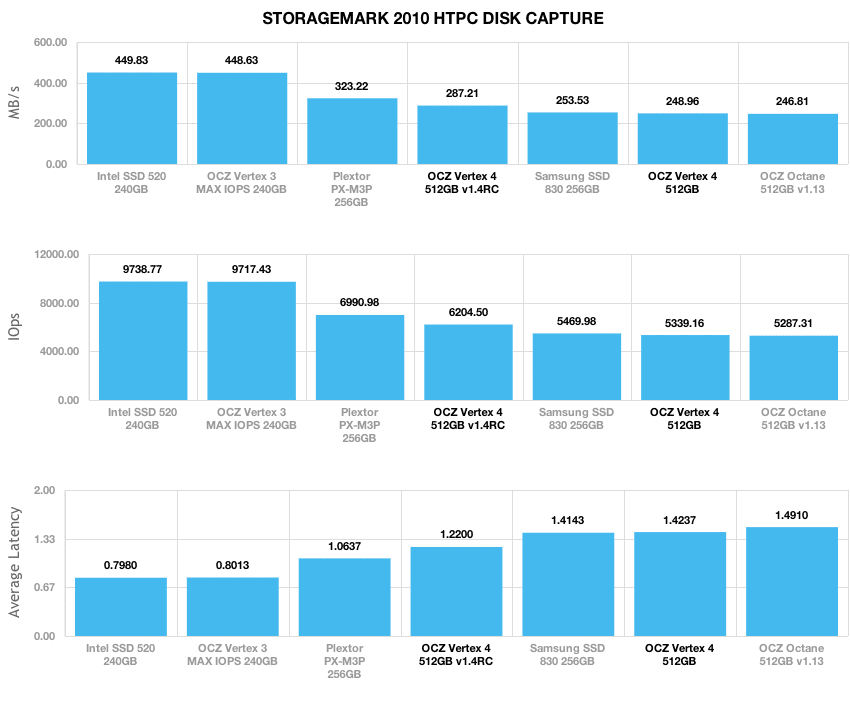
HTPC trace speed working in raw mode increased from 248MB/s average up to 287MB/s average with 1.4RC installed.
Our second real-life test covers disk activity in a productivity scenario. For all intents and purposes this test shows drive performance under normal daily activity for most users. This test includes: a three hour period operating in an office productivity environment with 32-bit Vista running Outlook 2007 connected to an Exchange server, web browsing using Chrome and IE8, editing files within Office 2007, viewing PDFs in Adobe Reader, and an hour of local music playback with two hours of additional online music via Pandora. In this trace we recorded 4,830MB being written to the drive and 2,758MB being read.
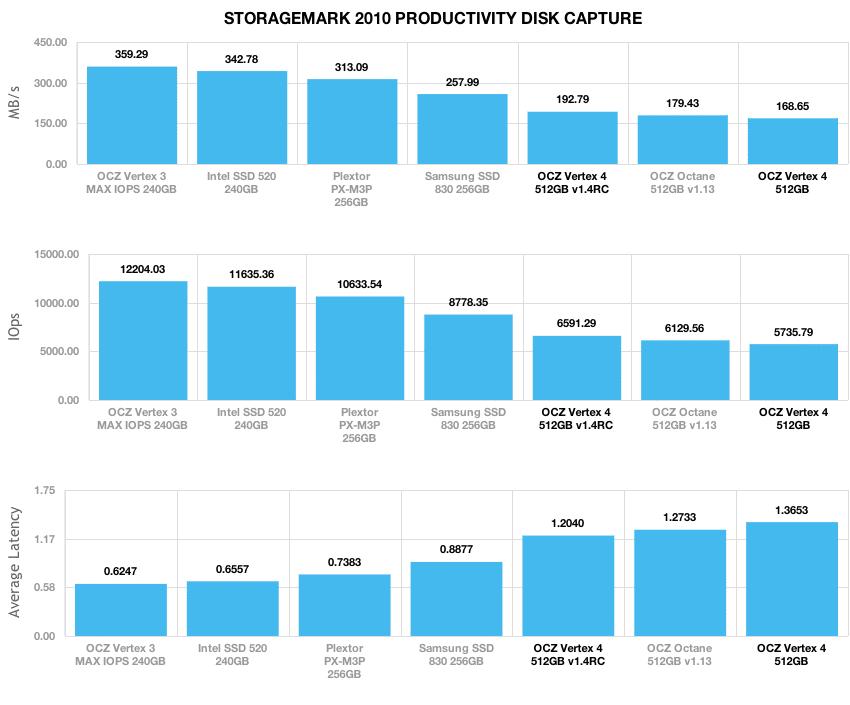
Productivity performance also picked up, moving from 168MB/s to 192MB/s average with 1.4RC firmware installed.
Our third real-life test covers disk activity in a gaming environment. Unlike the HTPC or Productivity trace, this one relies heavily on the read performance of a drive. To give a simple breakdown of read/write percentages, the HTPC test is 64% write, 36% read, the Productivity test is 59% write and 41% read, while the gaming trace is 6% write and 94% read. The test consists of a Windows 7 Ultimate 64-bit system pre-configured with Steam, with Grand Theft Auto 4, Left 4 Dead 2, and Mass Effect 2 already downloaded and installed. The trace captures the heavy read activity of each game loading from the start, as well as textures as the game progresses. In this trace we recorded 426MB being written to the drive and 7,235MB being read.
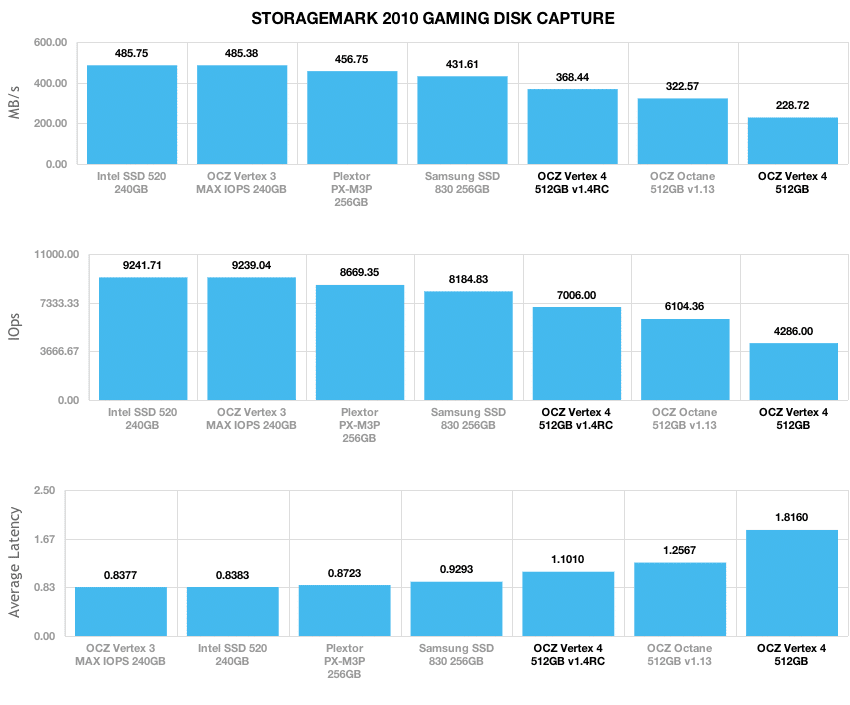
Gaming performance with a lot of read-activity saw a big boost in performance, increasing from 228MB/s average to 368MB/s.
Power Consumption
When looking at any modern SSD, power consumption is a huge deciding factor for many mobile shoppers, since the drive itself can make up a large portion of the total power used in a given notebook. In our power consumption tests we look at how much a given drive draws during read and write activities, as well as startup requirements and idle.

Across the board, the 512GB Vertex 4 with the new firmware offered better power characteristics, improving in all but startup requirements.
Conclusion
While the new firmware made the Vertex 4 better pretty much all around, there is a bit of a caveat to these results. During our steady state tests, the Vertex 4 didn’t respond well, dropping from our test system. After rebooting the machine the drive would re-appear, just to exhibit the same behavior again. To their credit OCZ has identified the issue and believes there will be a repair very soon.
For those who are very heavy users of their Vertex 4, it’s probably best to wait for the final firmware build before upgrading. For most users though, the release candidate is a good fix and drives tremendous performance upgrades. Even then, it’s worth noting that this firmware is not final and is probably best applied by those who are more performance oriented until the final firmware v1.4 is released.
When the final build is released StorageReview will re-evaluate and update our numbers.
UPDATE 6/14/12 – We have replaced our pre-production Vertex 4 samples with retail samples and the endurance testing issues we noted previously are gone with the latest firmware.
OCZ Vertex 4 at Amazon.com




 Amazon
Amazon